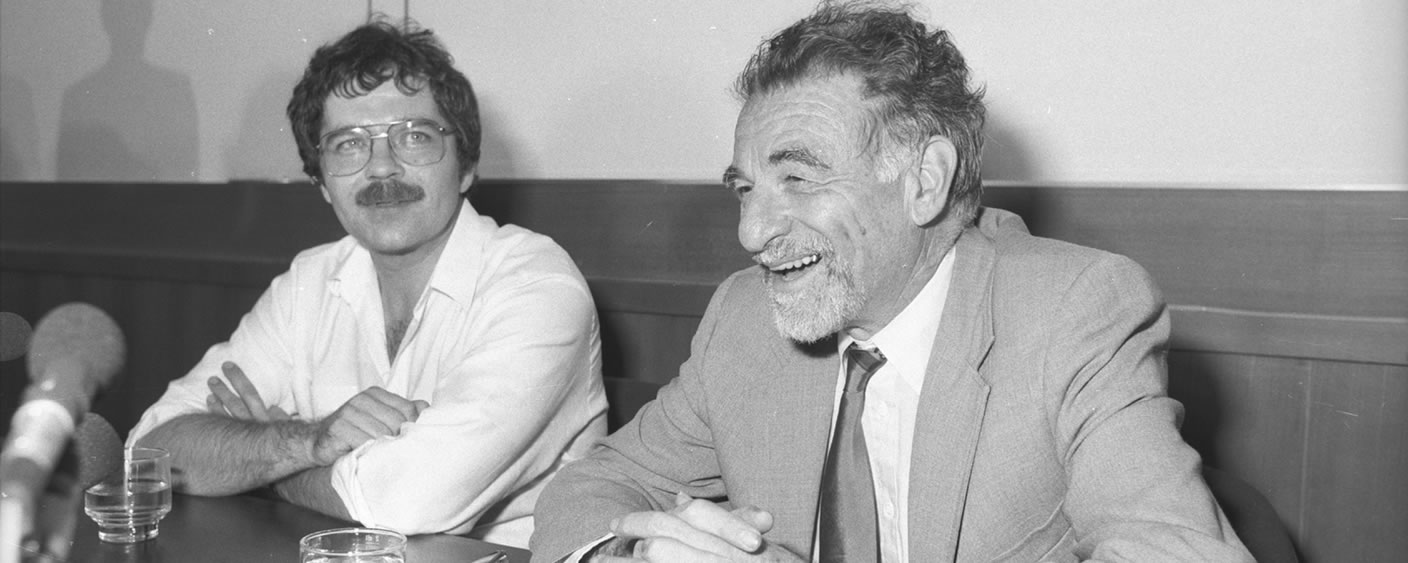Georg Bednorz (*1950); Karl Alexander Müller (*1927)

Nobel Prize winners for physics
On 8 December 1987 Swiss physicist Karl Alexander Müller and German mineralogist Georg Bednorz won the Nobel Prize in Physics for their discovery of high-temperature superconductivity in ceramics. This came as the crowning achievement of their longstanding collaboration at the IBM Research Lab in Rüschlikon.
Career of Karl Alexander Müller
Karl Alexander Müller was born in Basel on 20 April 1927. After the sudden death of his mother, he attended the Evangelische Mittelschule in Schiers from the age of eleven, where he developed a keen interest in electrical engineering. However, his chemistry teacher persuaded him to embark on a degree in physics. After leaving school and completing his national service, he studied physics at ETH Zurich from 1946 to 1952, including under the tutelage of Paul Scherrer and Wolfgang Pauli. Following a diploma thesis supervised by Professor G. Busch and a number of years gathering experience as an assistant and in industry, he completed a doctorate in paramagnetic resonance at ETH Zurich in 1958.
From 1959 to 1963, Müller was the head of the magnetic resonance group at the Battelle Memorial Institute in Geneva before moving to the IBM Research Lab in Rüschlikon, where he went on to run the Physics Department from 1971. As an IBM Fellow, he was able to devote his full attention to independent basic research from 1982. Müller was also a private lecturer at the University of Zurich from 1962, where he became an adjunct professor in 1970 and ultimately a full professor in 1987.
Life of Georg Bednorz
eorg Bednorz was born in Neuenkirchen, Germany, on 16 May 1950. He already began to develop an interest in practical mechanic and the sciences during his childhood. He embarked on a degree in chemistry at the University of Münster in 1968 but, overwhelmed by the sheer number of students, soon switched to mineralogy, specialising in crystallography. Bednorz spent the summer of 1972 at the IBM Research Lab in Rüschlikon, where Karl Alexander Müller had just been appointed as Head of the Physics Department.
At the Zurich research lab, which he visited once again in 1973 and 1974, he began to turn his attention to the characterisation and crystal growth of perovskites, which was the subject of his diploma thesis. Upon completing his degree in Münster, Bednorz embarked on a doctorate at ETH Zurich's Laboratory for Solid Particle Physics (under the tutelage of Heini Gränicher and external page Karl Alexander Müller) in 1977, which he completed in 1982 before joining Müller’s research team in Rüschlikon.
Collaboration of Müller and Bednorz
Bednorz and Müller began their joint, systematic analyses of the electric conductivity of ceramic materials formed from copper oxides in 1983. More specifically, their research focussed on identifying materials that conducted electric current without resistance at higher temperatures above absolute zero than the superconductive materials known at the time.
Discovery and further progress
In 1986 the two researchers discovered a ceramic material made of barium, lanthanum, copper and oxygen, in which electricity only flowed loss-free at minus 238 degrees (or 35 K). They therefore debunked the previous theories, which claimed that superconductivity would only appear from minus 250 degrees. The ground-breaking discovery meant that the new superconductor no longer had to be stored in helium, which was expensive and difficult to manage, but was just the ticket for liquid nitrogen, which was easier to control. The great response to the new high-temperature superconductor was also down to the fact that its economically and technologically lucrative utilisation was especially promising in the field of power engineering. It was assumed that a successful application and implementation of superconductivity would enable a significant number material and energy resources to be conserved.
While Karl Alexander Müller continued to work as a professor until his retirement in 1994, Georg Bednorz was also appointed as an IBM Fellow in 1987 and has been a member of the Executive Board at the University of Münster since 2008.
Holdings
Information on the life and work of Karl Alexander Müller and Georg Bednorz is available in their biographical dossiers in the ETH Zurich University Archives, which also include Müller's enrolment and doctoral documents and Bednorz's doctoral documents. The Historical School Board Archive also contains additional information on Müller's degree, the records of which are accessible online: Schulratsprotokolle Online. There are also two letters from Karl Alexander Müller to Res Jost in the University Archives.
All Nobel Prize laureates of ETH Zurich at a glance